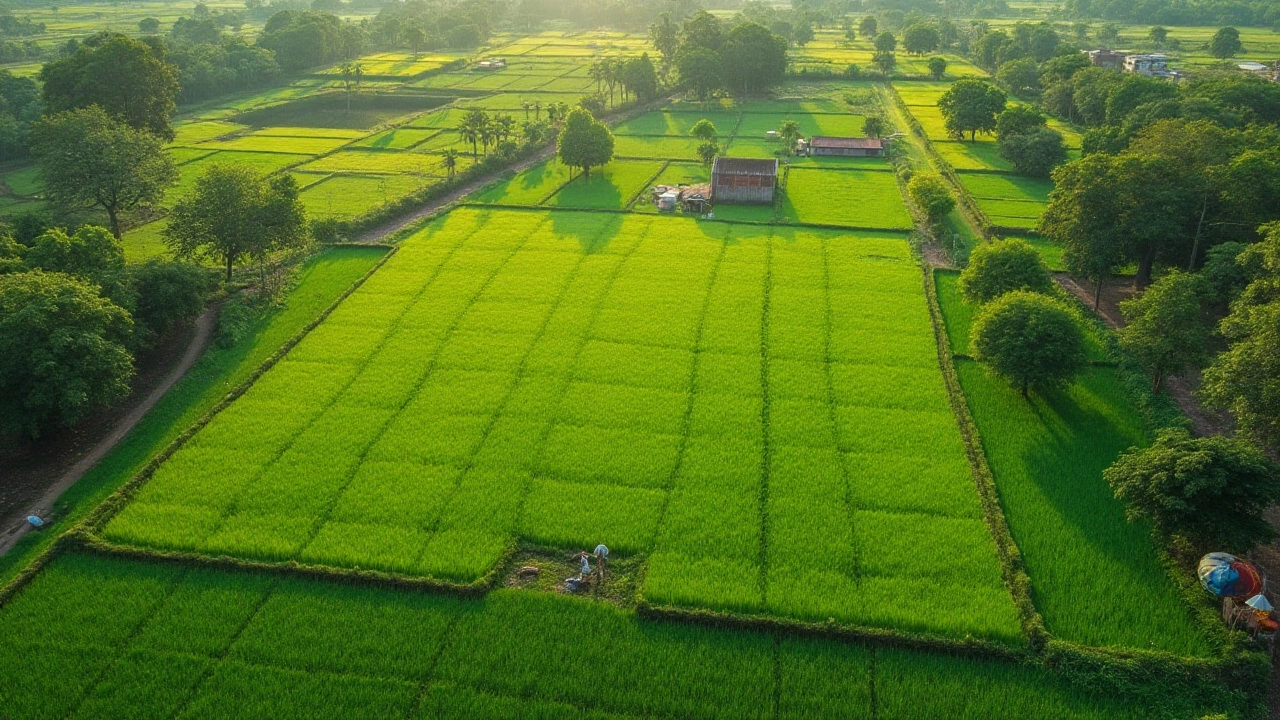When it comes to land, especially in the bustling world of real estate, understanding measurements can make a big difference in purchasing decisions. An 'acre' is such a common term, yet it's a unit of measure that can be hard to picture. Can it fit a soccer field? A basketball court? Understanding what 1 acre looks like can offer great insight whether you’re buying, selling, or simply curious.
The origins of the acre, with its deep historical roots, might surprise you, dating back to the days when land was measured by the amount a man could plow in a day. To truly grasp how much space an acre represents, drawing parallels with objects and areas we encounter daily can be incredibly helpful. While standard measures of an acre provide us with the statistics, it’s the human imagination that brings those numbers alive.
- Defining an Acre
- Historical Context of the Acre
- Real-World Comparisons
- Practical Tips for Visualization
- Importance in Real Estate
- Common Misconceptions
Defining an Acre
Comprehending an acre begins with understanding its roots in historical measurement systems. An acre is commonly known as a unit representing a piece of land equivalent to 43,560 square feet. This might sound like an odd number, but its derivation is logical when traced back to medieval England where land was measured through human labor output. Specifically, an acre was defined as the area that could be plowed by a yoke of oxen in a single day. This historical reference may give us insight into its seemingly arbitrary measurement.
The concept of an acre extends beyond just numbers; it integrates into various cultural and agricultural practices. For instance, in the real estate industry, understanding an acre's dimensions can heavily influence property valuation and planning. To visualize, one might consider that a standard American football field, excluding end zones, is about 1.32 acres in size, helping to highlight how vast yet manageable this unit is. The transition from agricultural measures to urban application showcases its adaptability.
The Oxford English Dictionary notes, "An acre is a unit principally utilized in the Commonwealth and United States, embodying a tradition of land valuation stretching over centuries."
For those in the property market, knowing how an acre translates into practical space is crucial when visualizing potential developments or investments. From farmland to residential lots, acres provide a reliable measure that ensures proportionate and fair distribution of land. Its standardized dimensions make it simpler for developers and buyers alike to understand what they are dealing with, promoting transparency in real estate transactions.
A fundamental aspect of appreciating an acre lies in being able to mentally map its dimensions. With technological advances, we now have applications that visually overlay dimensions onto any given location, assisting buyers and sellers in making informed decisions. Yet, traditional methods remain valuable; pacing out the distance or viewing drone footage can instill a tangible sense for the size. Whether you’re measuring land for agricultural purposes or estimating the right size for a backyard, keeping the cornerstone value of 43,560 square feet in mind is key.
Historical Context of the Acre
The concept of the acre hails from the Middle Ages, deriving from the Old English word 'æcer,' which referred to a field. This term originally described the amount of land a yoke of oxen could plow in a day, which roughly translates to its modern measurement. Over time, the definition became more precise. During the 13th century, King Edward I of England standardized the acre as a strip of land measuring four rods wide by forty rods long, equaling 660 feet by 66 feet, forming the rectangular form familiar to us today. The United States later adopted this standard measurement when delineating land, which has allowed for seamless transactions across state lines.
A fascinating fact is how the acre has been interwoven with agricultural practices throughout history. In medieval England, the two-unit system of rods and furlongs was commonly used, with eight furlongs making up a mile, each furlong consisting of 40 rods. By maintaining this consistent measurement over centuries, societies ensured uniformity in land allocation and usage. The acre served as a reliable measure of arable land, vital for farming and the livelihood of communities. Thomas Jefferson, a titan of American landscapes, was known for deliberations on land and advocated for methods of distribution which influenced land measurement standards in the early United States.
The usage and recognition of the acre have expanded beyond agriculture as urbanization progressed. As city boundaries stretched and shifted, so did the utility of the acre in legal and developmental realms. Historically, land measurements like the acre have saved communities from disputes by providing a common language for understanding land size and ownership. Today, an acre remains a benchmark for land transactions not just in farming, but also in real estate, where understanding the expanse of an acre can significantly alter value perceptions.
One fascinating aspect of the acre's history lies in how it so brilliantly illustrates the evolution of human settlement and agricultural prioritization. In the words of historian Edward Macadam, "Land and its division have always mirrored the societal structures surrounding them." Such narratives illuminate the intricate tapestry of how a simple field measurement has influenced economies and landscapes through the ages. As land continues to hold its place as an invaluable asset, the acre exemplifies a blend of history, economy, and cultural significance, proving the adage that some things never change, even as everything does.

Real-World Comparisons
Visualizing an acre can be a bit of a challenge unless you have something tangible to compare it to. The concept of an acre dates back to the Middle Ages, when it was defined as the amount of land tillable by one man behind a single ox in one day. In more contemporary measurements, an acre comprises 43,560 square feet. But numbers on a page can only convey so much. To truly grasp the vastness of acre visualization, let's delve into some real-world comparisons that might paint a clearer picture.
Imagine a football field, sans the end zones. In the United States, a football field is about 57,600 square feet including the end zones. When you remove these, the field is roughly one acre. Thus, wherever there’s a game on, and you're sitting in those stands, you're essentially looking at an acre of land. This makes it a uniquely handy scale for picturing land size, especially in a country where football is so popular. An interesting fact is that many school playgrounds and community parks are designed around this module, thereby offering a familiar setting.
Another relatable comparison is the tennis court. An acre can hold about 16 tennis courts side by side. So if you’re a fan of the sport and visualize your local tennis club, picturing an acre becoming much simpler with this frame of reference. It also offers a practical understanding when considering land development or recreational space planning where activities like tennis are in demand.
Land measurement and visualization often go hand-in-hand with popular urban landmarks. For instance, New York’s Central Park is about 843 acres. Although you might think of Central Park as sprawling and extensive, breaking it down into smaller chunks that are roughly an acre each can help understand just how populous and diverse its sections can be in terms of utility and natural beauty. This permits each acre to stand as a microcosm of the larger whole, offering a unique perspective on both nature and recreation.
“Establishing a clear image of what an acre looks like is crucial for anyone in the real estate arena. It bridges the gap between perception and reality.” – Real Estate Times
When considering real estate transactions, the ability to visualize land size can profoundly affect decision-making. A common exercise is to consider an acre in terms of home developments. Most residential lots, especially in urban areas, are far less than an acre. Typically, a single-family home with a sizeable yard might cover a quarter of an acre, depending on the location. Imagine fitting four such homes per acre and you start appreciating why so many larger estates or countryside properties refer to having multiple acres.
One might think of an acre as being substantial, yet it offers vast opportunities for various configurations. Whether examining layouts for agricultural purposes, subdividing for family dwellings, or developing commercial properties, it holds surprising flexibility. This is integral not just for those buying or selling property size but also for planners, developers, and architects aiming to harness the land's full potential.
Practical Tips for Visualization
Visualizing an acre might seem daunting at first, but with a few simple tricks, it becomes an accessible and relatable concept. An acre is officially defined as 43,560 square feet, and that number can start to mean more when compared to familiar environments. Imagine a large supermarket; the total area covered by the parking lot or even part of the store itself can fall within the bounds of an acre. Another popular comparison is with American football fields — an acre is about 90% the size of a standard field, including both end zones. This comparison is quite effective as many have watched or played sports on such a field, providing a solid and relatable visual reference.
For those visually inclined, drawing out an acre on paper or even using digital tools can be enlightening. On graph paper or a digital map, try sketching out an acre by creating a rectangle measuring approximately 208 feet by 209 feet. This hands-on approach offers a tangible sense of the area's magnitude. Walking out the dimensions in a nearby park or open field can also solidify this understanding. Taking 70 steps lengthwise and another 70 steps adjacent would roughly walk the boundary of a square acre, given the average human step is around 2.5 feet.
Incorporating technology, various online mapping tools can be handy for visual learners. By inputting specific measurements, these maps can project acreage over properties of interest, neighborhood parks, or familiar landmarks. This interactive experience makes the abstract concept of an acre more tangible and easily comprehensible. Moreover, apps that use augmented reality (AR) can create a virtual overlay of an acre in actual geographical spaces, offering a modern and engaging method to grasp scale accurately.
"The great thing about land is it doesn’t have to be explained, just experienced," says Richard Powers, a land consultant. His perspective underscores the need for people to walk, measure, and explore potential land purchases physically, to truly understand land measurements like an acre.
A more novel method involves converting the space into car parking capabilities. An acre can fit about 150 to 200 standard parking spaces, depending on how efficiently they are arranged. Visualizing your favorite shopping mall's parking lot filled with cars can lend a sense of how expansive an acre really is. Parking lot imagery works well, given that most people are familiar with the dimensions of car spaces.
These practical tips not only help in understanding and visualizing a singular acre, but they also aid prospective buyers and real estate professionals when comparing multiple pieces of land. Emphasizing land measurement in relatable ways ensures that stakeholders are well-informed, making decisions more confidently and accurately in the vibrant world of real estate.

Importance in Real Estate
In the realm of real estate, comprehending an acre's size is not just about grasping the dimensions—it is about understanding its intrinsic value. For buyers and sellers, this piece of knowledge can guide critical decisions, not unlike owning a map in a treasure hunt. An acre, equivalent to 43,560 square feet, underpins pricing strategies, development potentials, and even environmental considerations, making it a fundamental aspect of the industry.
An acre is often the standard measure when evaluating rural and suburban land parcels. Unlike urban environments where square footage reigns, mentioning “acreage” in listings adorns them with prestige, especially in areas where space is synonymous with luxury. To a prospective buyer, knowing that an acre could comfortably encompass about 75% of a soccer field can make the concept tangible and less abstract.
In densely populated areas, an acre can represent opportunity—a scope for development, be it residential, agricultural, or commercial initiatives. A single acre might host several mid-sized homes, a small farm, or even a cozy park, each use determining its market value significantly. When land is discussed in terms of acres rather than lots or parcels, it transcends its physical dimensions, symbolizing potential and promise.
The real estate market often sees fluctuations—property values may peak and plummet based on economic climates. Yet the value of an acre remains relatively stable, as it provides a timeless and standardized unit of measure that transcends trends. For those looking to invest, having an eye on the acreage is akin to holding a reservoir of tangible assets ready for varied possibilities.
Understanding acreage is not confined merely to measuring property lines. It implicates a myriad of considerations—from zoning laws that determine how land can be used, to environmental impacts, and even tax assessments. For example, an acre of prime agricultural land has different financial implications than an acre located in flood-prone territories, influencing financial decisions before making a purchase.
In a recent article from the "Real Estate Journal," it was noted,
"The traditional measure of an acre serves as the linchpin in assessing land investments, providing investors with a timeless certainty amidst volatile markets."This statement emphasizes the centrality of acreage measurement as a pillar in evaluating land worthiness. Thus, not only does knowing an acre matter—it is indispensable in real estate speculation, providing clarity in a world that frequently changes with the whims of economy.





